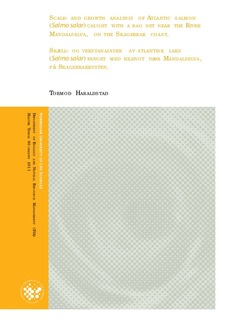| dc.contributor.author | Haraldstad, Tormod | |
| dc.date.accessioned | 2011-10-03T08:09:33Z | |
| dc.date.available | 2011-10-03T08:09:33Z | |
| dc.date.issued | 2011-10-03 | |
| dc.identifier.uri | http://hdl.handle.net/11250/186782 | |
| dc.description.abstract | The abundance of wild Atlantic salmon (Salmo salar) has declined since the 1970s. The major reason for the recent decline appears to be increased marine mortality. Before 1970s, the native populations of Atlantic salmon were exterminated in several rivers in Southern Norway due to acidification, but in the last two decades many of these have been re- established, due to liming of the rivers.
The aim of this study was to analyse marine growth of Atlantic salmon caught with bag net near the River Mandalselva on the Skagerrak coast in the years 2004-2010. The sampled fish were maturing adults, most of which were probably returning to the River Mandalselva or other rivers in the same area. I determined age and growth of the fish from the scales. The rate of measurement error from the scale reading was low so one reading of each scale was conducted. The sampling error declined when more scales per fish were measured. In this study I measured four scales per fish, a number that both took into account requirements for precision and the amount of work. The number of circuli deposited in the scales and the inter- circuli distances were measured. The growth rate of Atlantic salmon during the first year at sea was positively correlated with the number of circuli present at the end of the same period. The number of circuli deposited after the winter-band was positively related to the catch date. The inter-circuli distances increased rapidly after the smolt had entered the sea, reaching a point of inflection at circuli number six. There was a significant year-to-year variation in the total number of circuli deposited during both first and second growth year at sea. There was a reduction in the peaks of maximum inter-circuli distances for the multi-sea-winter (MSW) Atlantic salmon first growth year at sea over the entire study period, 2001-2008. The total number of circuli deposited during the first growth year at sea differed significantly between the one-sea-winter (1SW) and MSW Atlantic salmon. 1SW fish deposited a higher number of circuli than the MSW fishes.
The observed variations in growth while at sea were probably related to variation in temperature that acted directly on fish growth by affecting physical processes or indirectly by affecting changes in the ecosystem. Findings in this study highlight the importance of considering both circuli number and inter-circuli distances when studying Atlantic salmon growth rather than to solely rely on inter-circuli distances. | en_US |
| dc.language.iso | eng | en_US |
| dc.subject | Atlantic salmon | en_US |
| dc.subject | laks | en_US |
| dc.subject | growth analysis | en_US |
| dc.subject | vekstanalyser | en_US |
| dc.subject | scale analysis | en_US |
| dc.subject | skjellanalyser | en_US |
| dc.subject | Mandalselva | en_US |
| dc.subject | Salmo salar | en_US |
| dc.subject | bag net | en_US |
| dc.subject | kilenot | en_US |
| dc.subject | Norway | en_US |
| dc.title | Scale- and growth analysis of Atlantic salmon (salmo salar) caught with a bag net near the River Mandalselva, on the Skagerrak coast | en_US |
| dc.title.alternative | Skjell- og vekstanalyser av Atlantisk laks (Salmo salar) fanget med kilenot nær Mandalselva, på Skagerrakkysten) | en_US |
| dc.type | Master thesis | en_US |
| dc.subject.nsi | VDP::Mathematics and natural science: 400::Zoology and botany: 480 | en_US |
| dc.source.pagenumber | 59 | en_US |
